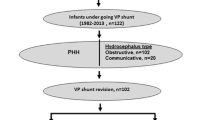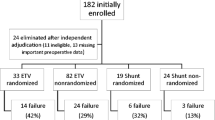Abstract
Purpose
Prior research has examined predictors of shunt failure in children with hydrocephalus and concluded that the majority of shunts do not survive long-term. However, risk factors such as etiology, birth weight, and gestational age may vary across institutions and populations. We sought to identify the social, clinical, and neonatal factors associated with initial ventriculoperitoneal (VP) shunt failure in the intraventricular hemorrhage (IVH) patient population and the patient population with an etiology other than IVH (non-IVH).
Methods
A retrospective review of patients, born during 2000–2005 diagnosed and treated for hydrocephalus at Children’s of Alabama was conducted. Survival analysis identified factors associated with time to shunt failure.
Results
Analyses were done separately for the IVH and non-IVH cohorts. Age and weight at initial VP shunt insertion were found to be associated with shunt failure in the non-IVH group (p < .05). Of the 238 patients in the non-IVH cohort, 108 failed within 2 years of their initial insertion. Fifty of those shunt failures occurred within 3 months of initial shunt placement. In the IVH cohort, 56 out of 100 failed within 2 years; 36 of those failed within 3 months post initial shunt insertion. When controlling for type of shunt failure, age at initial shunt placement was associated with time to shunt failure (p = .0004).
Conclusion
This study confirms previously published studies on the IVH population. A prospective cohort study and standardized clinical decision making are necessary to further assess the impact that shunting has on this patient population.




Similar content being viewed by others
References
Acakpo-Satchivi L, Shannon CN, Tubbs RS, Wellons JC 3rd, Blount JP, Iskandar BJ, Oakes WJ (2008) Death in shunted hydrocephalic children: a follow-up study. Childs Nerv Syst 24(2):197–201
Behjati S, Emami-Naeini P, Nejat F, El Khashab M (2011) Incidence of hydrocephalus and the need to ventriculoperitoneal shunting in premature infants with intraventricular hemorrhage: risk factors and outcome. Childs Nerv Syst 27(6):985–989. doi:10.1007/s00381-010-1387-4
Bergsneider M, Egnor MR, Johnston M, Kranz D, Madsen JR, McAllister JP 2nd, Stewart C, Walker ML, Williams MA (2006) What we don't (but should) know about hydrocephalus. J Neurosurg 104(3 Suppl):157–159
Bondurant CP, Jimenez DF (1995) Epidemiology of cerebrospinal fluid shunting. Pediatr Neurosurg 23(5):254–258, discussion 259
Browd SR, Gottfried ON, Ragel BT, Kestle JR (2006) Failure of cerebrospinal fluid shunts: part II: overdrainage, loculation, and abdominal complications. Pediatr Neurol 34(3):171–176
Bryant MJ, McEniery J, Walker DG, Campbell R, Lister B, Sargent P, Withers TK, Baker J, Guazzo E, Rossato R, Anderson D, Tomlinson F (2004) Preliminary study of shunt related death in paediatric patients. J Clin Neurosci 11(6):614–615
Drake JM, Kestle JR, Tuli S (2000) CSF shunts 50 years on—past, present and future. Childs Nerv Syst 16(10–11):800–804
Epstein FJ, Hochwald GM, Wald A, Ransohoff J (1975) Avoidance of shunt dependency in hydrocephalus. Dev Med Child Neurol Suppl 35:71–77
Fisher R (1967) Surgery of the congenital anomalies. In: Walker AE (ed) A History of Neurological Surgery. Hafner Publishing, New York, pp 334–361
Fulkerson DH, Vachhrajani S, Bohnstedt BN, Patel NB, Patel AJ, Fox BD, Jea A, Boaz JC (2011) Analysis of the risk of shunt failure or infection related to cerebrospinal fluid cell count, protein level, and glucose levels in low-birth-weight premature infants with posthemorrhagic hydrocephalus. J Neurosurg Pediatr 7(2):147–151. doi:10.3171/2010.11.PEDS10244
Kestle J, Cochrane D, Alisharan R (2000) The initial treatment of hydrocephalus: an assessment of surgeons' preference between third ventriculostomy and shunt insertion. Neurol Res 22(1):65–68
Kestle J, Drake J, Milner R, Sainte-Rose C, Cinalli G, Boop F, Piatt J, Haines S, Schiff S, Cochrane D, Steinbok P, MacNeil N (2000) Long-term follow-up data from the Shunt Design Trial. Pediatr Neurosurg 33(5):230–236
Kestle J, Milner R, Drake J (1999) The shunt design trial: variation in surgical experience did not influence shunt survival. Pediatr Neurosurg 30(6):283–287
Kestle JR, Drake JM, Cochrane DD, Milner R, Walker ML, Abbott R 3rd, Boop FA (2003) Lack of benefit of endoscopic ventriculoperitoneal shunt insertion: a multicenter randomized trial. J Neurosurg 98(2):284–290
Kestle JR, Garton HJ, Whitehead WE, Drake JM, Kulkarni AV, Cochrane DD, Muszynski C, Walker ML (2006) Management of shunt infections: a multicenter pilot study. J Neurosurg 105(3 Suppl):177–181
Kestle JR, Hoffman HJ, Soloniuk D, Humphreys RP, Drake JM, Hendrick EB (1993) A concerted effort to prevent shunt infection. Childs Nerv Syst 9(3):163–165
Kestle JR, Walker ML (2005) A multicenter prospective cohort study of the Strata valve for the management of hydrocephalus in pediatric patients. J Neurosurg 102(2 Suppl):141–145
Kulkarni AV (2006) Questionnaire for assessing parents' concerns about their child with hydrocephalus. Dev Med Child Neurol 48(2):108–113
Kulkarni AV, Drake JM, Rabin D, Dirks PB, Humphreys RP, Rutka JT (2004) Measuring the health status of children with hydrocephalus by using a new outcome measure. J Neurosurg 101(2 Suppl):141–146
Kulkarni AV, Rabin D, Drake JM (2004) An instrument to measure the health status in children with hydrocephalus: the Hydrocephalus Outcome Questionnaire. J Neurosurg 101(2 Suppl):134–140
Mapstone TB, Rekate HL, Nulsen FE, Dixon MS Jr, Glaser N, Jaffe M (1984) Relationship of CSF shunting and IQ in children with myelomeningocele: a retrospective analysis. Childs Brain 11(2):112–118
Martin JE, Keating RF, Cogen PH, Midgley FM (2003) Long-term follow-up of direct heart shunts in the management of hydrocephalus. Pediatr Neurosurg 38(2):94–97
McGirt MJ, Leveque JC, Wellons JC 3rd, Villavicencio AT, Hopkins JS, Fuchs HE, George TM (2002) Cerebrospinal fluid shunt survival and etiology of failures: a seven-year institutional experience. Pediatr Neurosurg 36(5):248–255
Piatt JH Jr (1995) Cerebrospinal fluid shunt failure: late is different from early. Pediatr Neurosurg 23(3):133–139
Piatt JH Jr, Carlson CV (1993) A search for determinants of cerebrospinal fluid shunt survival: retrospective analysis of a 14-year institutional experience. Pediatr Neurosurg 19(5):233–241, discussion 242
Prigatano GP, Zeiner HK, Pollay M, Kaplan RJ (1983) Neuropsychological functioning in children with shunted uncomplicated hydrocephalus. Childs Brain 10(2):112–120
Sainte-Rose C, Piatt JH, Renier D, Pierre-Kahn A, Hirsch JF, Hoffman HJ, Humphreys RP, Hendrick EB (1991) Mechanical complications in shunts. Pediatr Neurosurg 17(1):2–9
Tubbs RS, Smyth MD, Wellons JC 3rd, Blount JP, Grabb PA, Oakes WJ (2003) Life expectancy of ventriculosubgaleal shunt revisions. Pediatr Neurosurg 38(5):244–246
Tuli S, Drake J, Lawless J, Wigg M, Lamberti-Pasculli M (2000) Risk factors for repeated cerebrospinal shunt failures in pediatric patients with hydrocephalus. J Neurosurg 92(1):31–38
Tuli S, O'Hayon B, Drake J, Clarke M, Kestle J (1999) Change in ventricular size and effect of ventricular catheter placement in pediatric patients with shunted hydrocephalus. Neurosurgery 45(6):1329–1333, discussion 1333-1325
Tuli S, Tuli J, Drake J, Spears J (2004) Predictors of death in pediatric patients requiring cerebrospinal fluid shunts. J Neurosurg 100(5 Suppl Pediatrics):442–446
Willis BK, Kumar CR, Wylen EL, Nanda A (2005) Ventriculosubgaleal shunts for posthemorrhagic hydrocephalus in premature infants. Pediatr Neurosurg 41(4):178–185. doi:10.1159/000086558
Author information
Authors and Affiliations
Corresponding author
Rights and permissions
About this article
Cite this article
Shannon, C.N., Acakpo-Satchivi, L., Kirby, R.S. et al. Ventriculoperitoneal shunt failure: an institutional review of 2-year survival rates. Childs Nerv Syst 28, 2093–2099 (2012). https://doi.org/10.1007/s00381-012-1830-9
Received:
Accepted:
Published:
Issue Date:
DOI: https://doi.org/10.1007/s00381-012-1830-9




